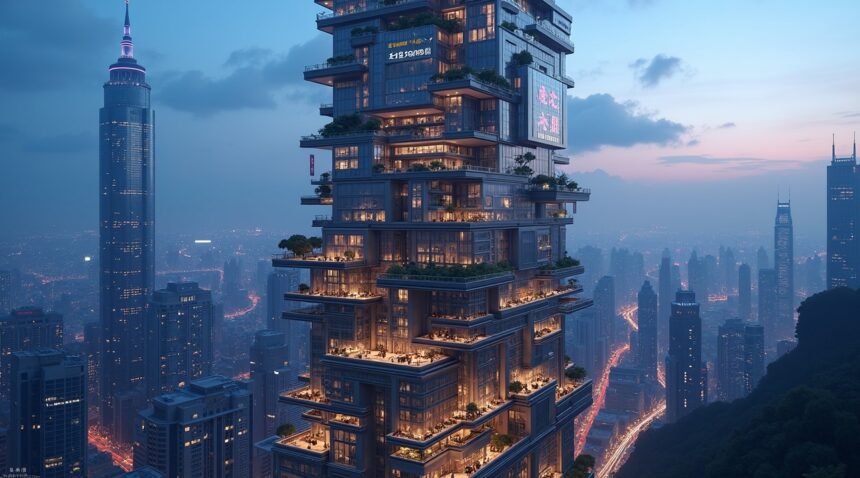Regent International in Hangzhou, China, represents a pioneering concept in modern urban living—a 675-foot tall vertical city that accommodates approximately 20,000 residents under one roof in a self-sufficient community.
Key Takeaways
- Massive Scale: The building houses 20,000–30,000 residents across 260,000 square meters, making it one of the largest residential complexes in China.
- Complete Self-Sufficiency: Residents can access shopping, dining, healthcare, education, entertainment, and even work opportunities within the building itself, eliminating the need to step outside.
- Affordable Housing Model: Windowless apartments are available for rent at approximately $210 per month, while units with balconies cost around $570, appealing primarily to young professionals and students.
- Black Mirror Comparisons: Due to its isolated and fully-contained nature, the tower has been likened to a dystopian setting where residents may live their entire lives within its confines.
- Urban Planning Experiment: Initially envisioned as a luxury hotel, the structure has evolved into a real-world case study for extreme high-density living, drawing interest from urban planners across the globe.
With its unique integration of daily life essentials, Regent International challenges traditional models of urban design and offers insight into how cities might accommodate growing populations in the future.
Inside China’s Colossal 675-Foot Tower That Houses 30,000 People
I’ve witnessed many impressive architectural feats, but Regent International in Hangzhou’s Qianjiang Century City stands as something truly extraordinary. This massive structure towers 675 feet (205 meters) above the ground and sprawls across an incredible 260,000 square meters, creating what might be one of the most ambitious residential projects ever constructed.
The building houses somewhere between 20,000 and 30,000 residents, depending on which source you consult. This staggering population density transforms the skyscraper into what essentially amounts to a vertical city. I find it remarkable that a single building can accommodate more people than many small towns across America.
A Self-Contained Urban Environment
What makes Regent International particularly fascinating is its design as a completely self-sufficient ecosystem. Residents can access everything they need without ever stepping outside:
- Shopping centers and retail outlets on multiple floors
- Restaurants and food courts offering diverse dining options
- Medical facilities and healthcare services
- Educational institutions and childcare centers
- Entertainment venues and recreational spaces
- Office spaces for remote work opportunities
- Fitness centers and sports facilities
This comprehensive approach to mixed-use development creates an environment where residents genuinely have no compelling reason to venture beyond the building’s walls. The structure ranks among the largest residential buildings in China, and its scale becomes even more impressive when you consider that greatest video game stories often feature similarly massive, self-contained environments.
The comparison to Black Mirror episodes isn’t entirely unfounded. The series often explores how technology and urban planning can create isolated communities, and Regent International embodies this concept in physical form. Unlike fictional scenarios where people might live at sea forever, these residents have chosen vertical isolation in the heart of a bustling city.
I observe that this mega-building represents a significant shift in how we think about urban living. While some might view it as dystopian, others see it as an efficient solution to China’s housing challenges and rapid urbanization. The building’s success demonstrates that people will adapt to radically different living situations when the infrastructure supports their daily needs.
The economic implications are substantial as well. When tech companies invest billions in virtual spaces like Meta’s metaverse, which sometimes attracts surprisingly few users, projects like Regent International prove that physical mega-structures can successfully house thousands of people in concentrated spaces.
The building’s design philosophy challenges traditional notions of community and urban planning. Instead of spreading residents across neighborhoods, it concentrates them vertically while providing horizontal amenities. This approach maximizes land use efficiency in densely populated areas like Hangzhou, where space comes at a premium.
Regent International functions as more than just housing—it’s a social experiment in modern living. The residents create their own micro-society within the tower’s walls, developing social networks and daily routines that rarely require external interaction. This level of self-containment represents a new frontier in urban architecture, one that other countries are watching closely as they grapple with their own housing crises and space limitations.
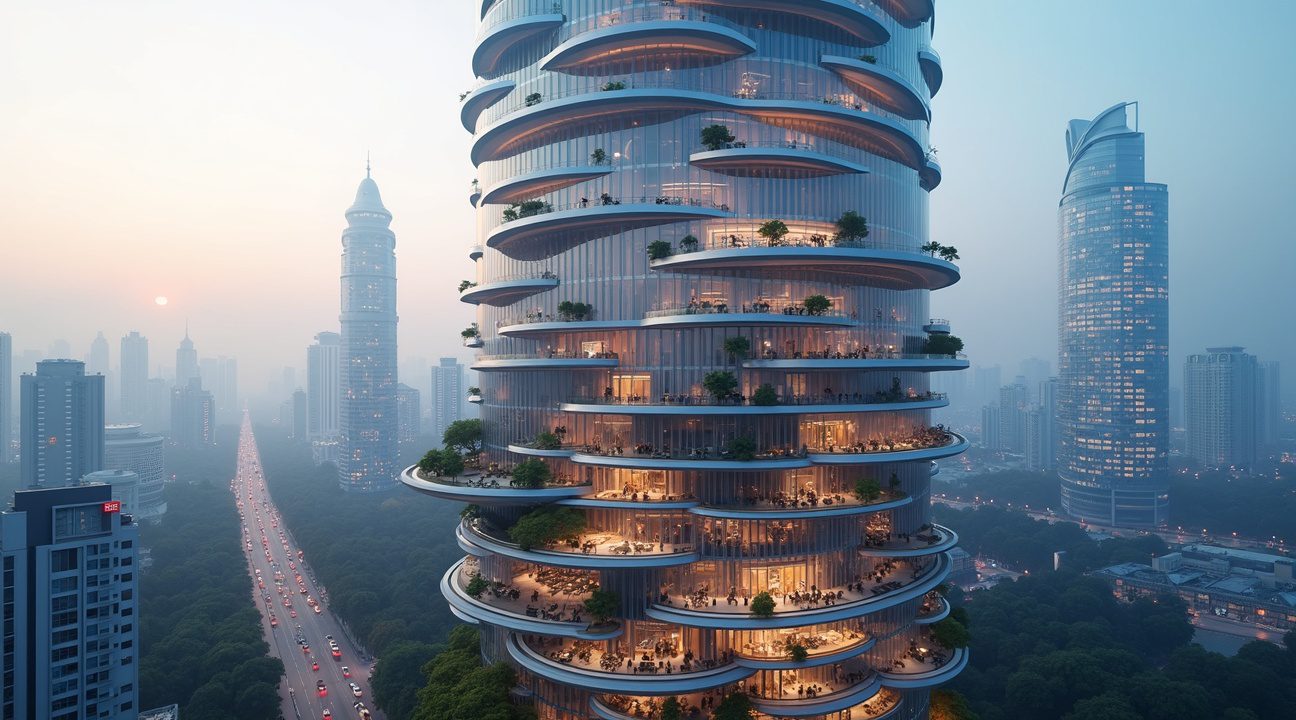
A Complete Urban Ecosystem Under One Roof Where Residents Never Need to Step Outside
Regent International stands as a towering testament to modern urban planning, housing approximately 20,000 residents in what can only be described as a vertical metropolis. This architectural marvel functions as a completely self-contained environment where stepping outside becomes a choice rather than a necessity.
Everything You Need Within Walking Distance
The building’s designers created an impressive array of facilities that mirror a traditional neighborhood’s offerings:
- Medium-sized supermarkets stocked with daily essentials and fresh produce
- Multiple food courts featuring diverse dining options
- Internet cafes providing connectivity and workspace alternatives
- Fully equipped gyms and swimming pools for fitness enthusiasts
- Professional barber shops and nail salons for personal grooming
- Comprehensive laundry services eliminating household chores
This comprehensive infrastructure ensures residents can access virtually every service they’d typically seek in an external urban environment. The building operates as its own world, earning the nickname “a city within a city” from both residents and observers.
Living in such a space creates an existence that feels oddly reminiscent of dystopian narratives where isolated communities develop their own social ecosystems. Residents develop routines that rarely require them to venture beyond the building’s walls, creating a lifestyle that prioritizes convenience above traditional outdoor experiences.
The complex’s design philosophy centers on accessibility and efficiency. Everything from grocery shopping to social interaction happens within the same structure where people sleep and work. This proximity eliminates commute times and weather-related inconveniences that typically influence daily decisions.
Some residents report going weeks without stepping outside, not from any restriction, but simply because their needs are met internally. The building creates its own weather-independent environment where seasonal changes become irrelevant to daily life. Social connections form within the building’s corridors and common areas, fostering a unique community dynamic.
While this concept might seem like something from a futuristic digital world, it represents a very real approach to urban density challenges. The building addresses housing shortages while providing unprecedented convenience levels that traditional apartment complexes can’t match.
Critics argue this lifestyle disconnects residents from natural environments and broader city experiences. However, supporters point to the reduced environmental impact and enhanced quality of life that comes from having everything within reach. The building essentially functions as a miniature city where residents can live, work, shop, and socialize without ever needing to navigate external urban challenges.
Who Lives in This Vertical City and Why They Choose Windowless Apartments
The Primary Demographics of Regent International Residents
Young professionals and students make up the vast majority of Regent International’s 20,000 residents. This demographic gravitates toward the building for practical reasons that align with their career and educational phases. Early-career professionals appreciate the central location within Shanghai’s business district, which eliminates lengthy commutes and connects them directly to employment opportunities.
Students find the building particularly attractive because it offers independence while maintaining affordability. The concentrated population of peers creates a built-in social network that many young people crave in a large metropolitan area. I’ve observed that this demographic often prioritizes convenience and cost-effectiveness over traditional living arrangements, making Regent International an ideal match for their lifestyle needs.
The Economics of Windowless Living
Rent prices at Regent International vary dramatically based on apartment features, particularly window access. The most affordable units without windows rent for approximately 1,500 RMB monthly, which equals about $210. These windowless apartments attract budget-conscious residents who prioritize savings over natural light exposure.
Larger units featuring balconies command significantly higher prices at around 4,000 RMB monthly, roughly $570. This price differential demonstrates how natural light and outdoor access influence rental markets even within unconventional housing structures. The stark contrast between these price points reflects residents’ willingness to sacrifice traditional comforts for financial benefits.
Several factors drive young people to accept windowless living conditions:
- Proximity to employment centers reduces transportation costs and time
- All-inclusive amenities eliminate the need for external services
- Built-in social opportunities through shared spaces and dense population
- Lower living expenses allow for increased savings or discretionary spending
- Modern conveniences compensate for architectural limitations
The building’s comprehensive amenities create a self-contained ecosystem that appeals to residents seeking convenience. Food courts, shopping areas, fitness facilities, and entertainment venues eliminate many reasons to venture outside. This setup particularly attracts individuals who prefer streamlined living arrangements where multiple needs get met within a single location.
Privacy concerns don’t deter many residents, especially younger demographics accustomed to shared living spaces from university dormitories or family homes. The trade-off between personal space and affordable urban living often favors practicality for this group. Many residents view the temporary nature of their stay as acceptable, planning to upgrade their living situations as their careers advance.
Limited natural light poses health considerations that some residents accept as part of their housing compromise. Young people often adapt more readily to artificial lighting environments, particularly those already spending significant time indoors for work or study. The building’s internal lighting systems attempt to compensate for the absence of windows, though they cannot fully replicate natural sunlight benefits.
Urban isolation risks exist despite the high population density, creating a paradox where residents can feel lonely while surrounded by thousands of neighbors. However, many young residents actively combat this through the building’s social spaces and organized activities. The concentration of similar-aged individuals often leads to friendship formation and community building that might be more difficult in traditional housing arrangements.
Location advantages in Shanghai’s business district provide residents with career networking opportunities and reduced commuting stress. This positioning allows young professionals to maximize their time and energy for career development rather than transportation. The building’s popularity among this demographic has created an environment where professional connections naturally develop through daily interactions.
Despite unconventional living conditions, many residents appreciate the predictability and simplicity of their housing arrangement. Fixed costs, included utilities, and comprehensive services create financial stability that appeals to individuals managing entry-level salaries or student budgets. This housing model represents a practical solution for urban living challenges faced by young people in expensive metropolitan areas like Shanghai.
For a closer look at life inside the Regent International project, watch this video:
https://www.youtube.com/watch?v=UoPoOQGxGYY
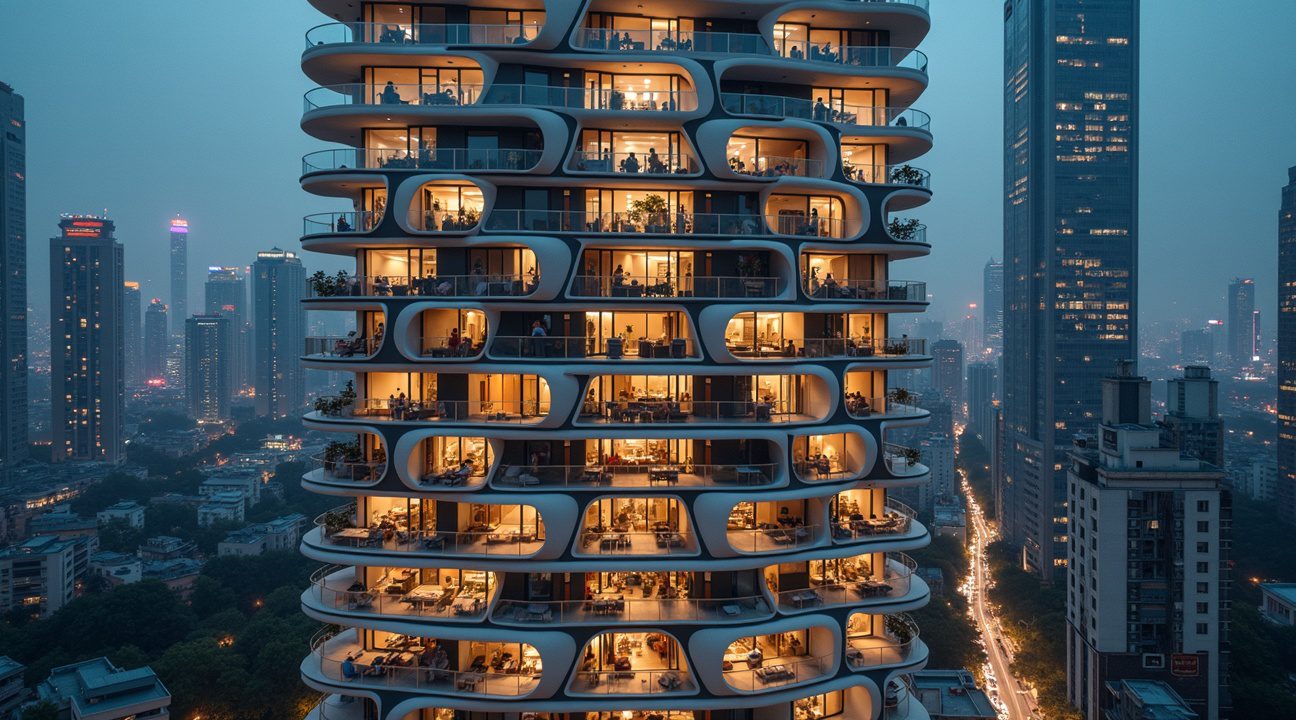
From Luxury Hotel Dream to Mass Housing Reality
The Regent International building started life with much grander aspirations than its current purpose suggests. Alicia Loo, the visionary designer behind Singapore’s iconic Sands Hotel, originally conceived this massive structure as a six-star luxury hotel that would redefine hospitality standards. The initial blueprint promised an experience that would rival the world’s most prestigious accommodations.
However, economic realities and market demands forced a dramatic pivot. The project transformed from an exclusive hotel destination into a high-density residential complex housing approximately 20,000 residents. This shift fundamentally altered the building’s purpose while preserving many of its original design DNA elements.
Luxury Elements in a Residential Framework
Despite the functional transformation, the building retains numerous high-end design features that reflect its hotel origins. The common areas showcase luxurious finishes, dramatic lighting installations, and architectural details that wouldn’t look out of place in a premium hospitality venue. Grand lobbies with soaring ceilings create an impressive first impression, while shared spaces maintain the aesthetic standards originally intended for discerning hotel guests.
The amenities mirror those found in luxury resorts. Residents have access to:
- Swimming pools
- Fitness centers
- Entertainment venues
- Dining facilities
These features create an all-encompassing environment where inhabitants can meet most of their daily needs without leaving the building’s confines.
This combination of luxury aesthetics with mass housing functionality creates an unsettling paradox. The building’s impressive facade and premium amenities mask the reality of its dense living conditions. Twenty thousand people sharing one structure represents an unprecedented concentration of humanity in a single building, creating living conditions that feel simultaneously luxurious and dystopian.
The architectural grandeur serves as a facade for what many observers describe as a Black Mirror scenario. The building’s self-contained nature means residents rarely need to venture outside, creating a microcosm that feels disconnected from the broader world. This isolation, combined with the building’s imposing scale and luxury-meets-efficiency design philosophy, evokes the kind of sterile, controlled environments frequently depicted in dystopian fiction.
The transformation from hotel to residential complex represents more than just a change in function. It symbolizes how modern urban planning increasingly prioritizes efficiency and density over traditional community structures, creating environments that feel more like contained worlds than integrated neighborhoods.
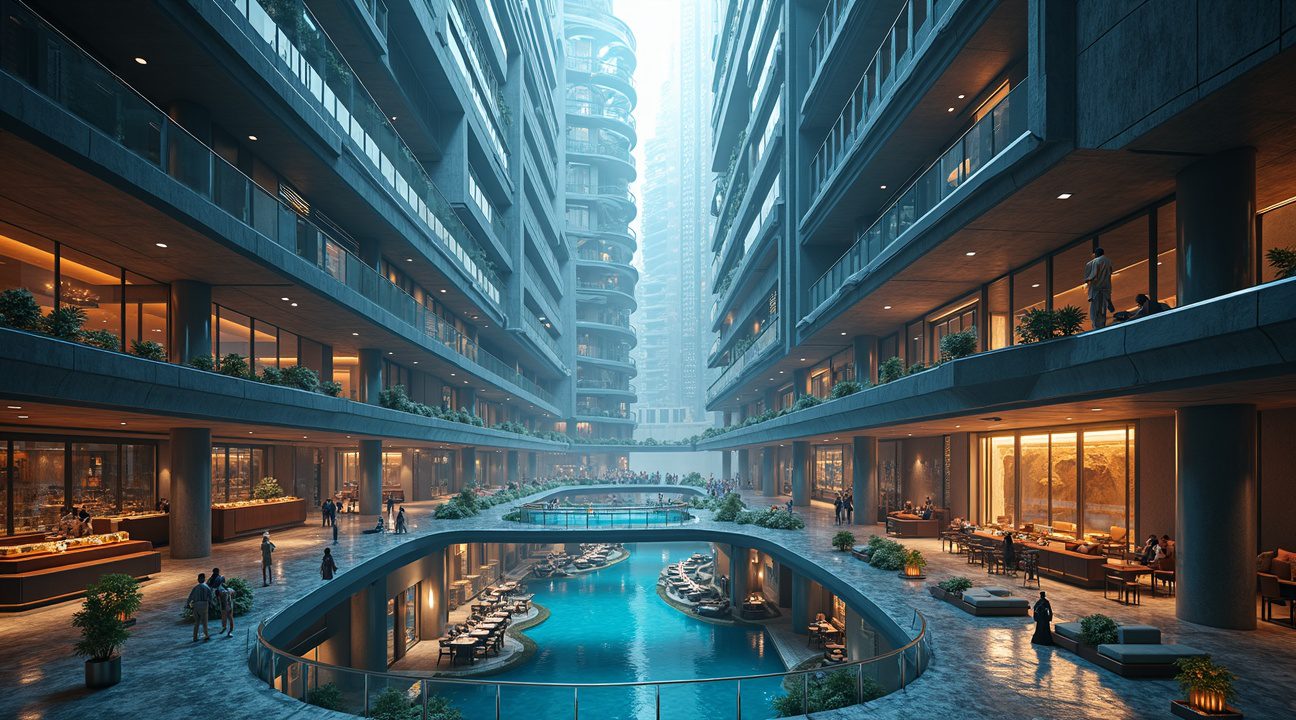
Ancient Underground Cities vs Modern Vertical Living: A Tale of Two Mega-Structures
The concept of housing massive populations within a single structure isn’t new. Derinkuyu, the ancient underground city carved into volcanic rock in Turkey’s Cappadocia region, once sheltered up to 20,000 people beneath the earth’s surface. This subterranean marvel shares striking similarities with Regent International, though their purposes couldn’t be more different.
Derinkuyu served as humanity’s answer to survival in hostile times. Built between the 8th and 7th centuries BCE, this underground complex extended eight levels deep into the earth. Residents retreated here during invasions, creating a self-sufficient ecosystem that could sustain thousands for months. The city featured ventilation shafts, wells, storage rooms, stables, chapels, and even schools—everything needed for extended isolation from the outside world.
Purpose-Driven Design Philosophy
I find the contrast between these two mega-structures fascinating. Derinkuyu emerged from necessity, born from the constant threat of warfare and persecution. Early Christians and other communities needed protection from Arab raids and Byzantine persecution. They carved living spaces, storage areas, and communal facilities directly into the soft volcanic rock, creating a fortress that enemies couldn’t penetrate or easily discover.
Regent International represents the opposite motivation. This modern tower caters to urban convenience and lifestyle optimization. Residents choose this environment not for protection, but for the promise of never needing to leave. The building houses shopping centers, restaurants, schools, offices, and entertainment facilities. It’s a vertical city designed around comfort rather than survival, efficiency rather than defense.
Innovation Through Different Lenses
Both structures showcase remarkable human ingenuity in high-density living solutions. The engineers of Derinkuyu mastered underground architecture without modern tools or technology. They created sophisticated ventilation systems that could supply fresh air to thousands of people living dozens of meters below ground. Rolling stone doors weighing hundreds of kilograms could seal off sections during attacks. The city included wine cellars, oil storage areas, and even livestock quarters.
Modern architects designing Regent International faced different challenges. They had to create vertical communities that eliminate the need for external urban infrastructure. The building functions as a self-contained ecosystem where residents can work, shop, dine, exercise, and socialize without stepping outside. Digital entertainment systems and virtual connectivity replace the physical exploration that traditional city living requires.
The scale of both projects demonstrates humanity’s ability to reimagine living arrangements:
- Derinkuyu: Networked underground levels, narrow tunnels, hidden passages, and communal spaces for survival and defense.
- Regent International: Vertical expansion with swimming pools, gyms, medical facilities, educational centers, and business offices for modern convenience.
Derinkuyu could accommodate livestock, store enough food for extended sieges, and maintain sanitation systems that prevented disease outbreaks. Regent International achieves similar population density through vertical expansion rather than underground excavation. The tower’s design incorporates everything residents need within its walls. Its internal economy means residents can earn money, spend it, and fulfill all daily needs without external dependencies.
The psychological implications differ dramatically between these two approaches:
- Derinkuyu’s inhabitants saw isolation as temporary and tied to external threats. They maintained surface connections, knowing they would one day return to open air.
- Regent International’s residents choose long-term isolation as a lifestyle, embracing a self-sustained vertical ecosystem for convenience and efficiency.
Both mega-structures reflect their eras’ technological capabilities and social priorities. Derinkuyu used manual labor and simple tools to create complex underground networks. Its builders understood geology, ventilation, and defensive architecture. Regent International employs modern engineering, climate control, and digital infrastructure to create vertical communities. Each represents the pinnacle of its time’s architectural ambition and social organization.
These parallel examples prove that high-density living solutions emerge from different motivations but achieve similar population concentrations. Whether driven by survival instincts or lifestyle preferences, humans consistently find ways to create self-sufficient communities that minimize external dependencies while maximizing internal resources and social connections.
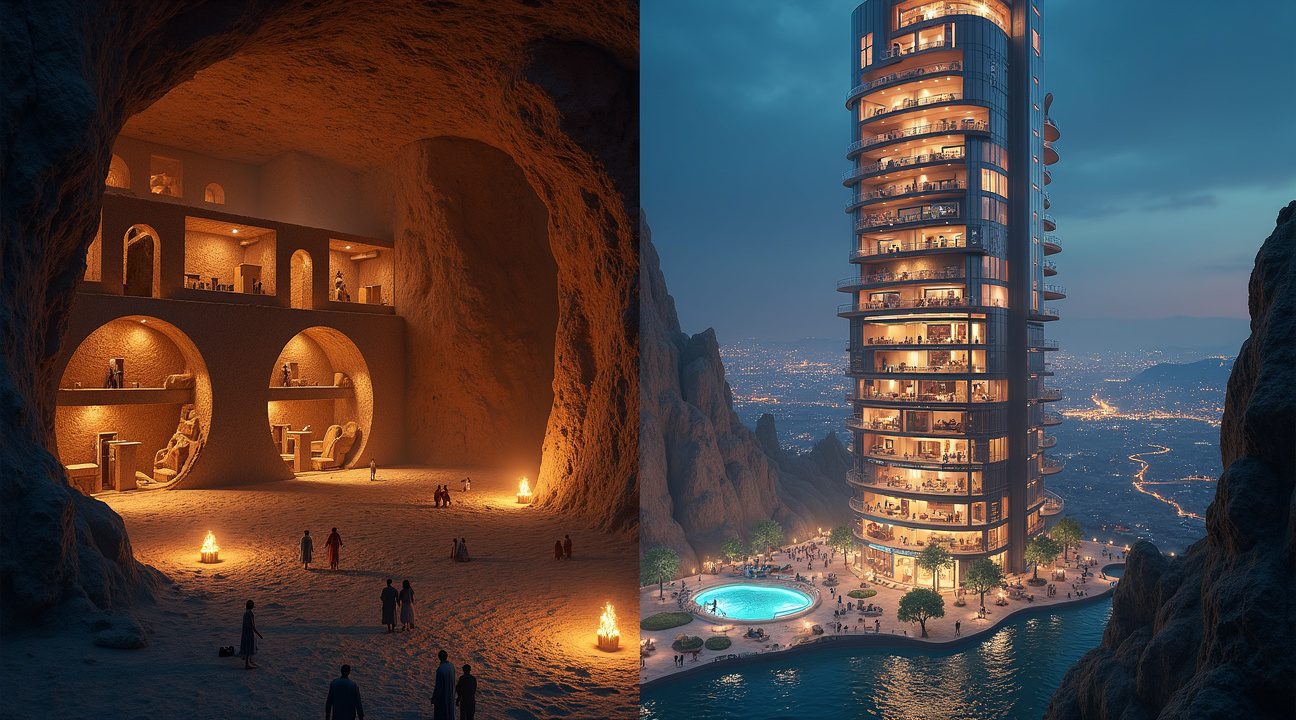
Why the World Calls It the “Black Mirror Building” and What It Says About Our Future
The Regent International’s unsettling nickname emerged naturally from observers who couldn’t shake the feeling they were witnessing something straight from Charlie Brooker’s dystopian anthology series. Black Mirror episodes consistently explore how technological advancement and urban efficiency can strip away human connection, making the comparison almost inevitable. I find the building’s promise that residents “never have to go outside” both fascinating and deeply concerning—a perfect encapsulation of our modern tension between convenience and community.
Social media platforms have amplified this comparison, with viral videos showcasing the building’s self-contained ecosystem spreading across TikTok, Twitter, and YouTube. These clips often highlight the eerie uniformity of the residential floors, the endless corridors, and the fact that thousands of people can live their entire lives within these walls. Content creators frame the footage with ominous music and commentary about surveillance states and social isolation, cementing the Black Mirror association in public consciousness.
The nickname reflects broader anxieties about where urban development is heading. Cities worldwide grapple with housing shortages and overpopulation, leading to increasingly dense living solutions. While Regent International represents an extreme efficiency model, it raises uncomfortable questions about what we’re willing to sacrifice for affordable housing. The building essentially functions as a vertical city, complete with shopping, dining, entertainment, and work spaces—eliminating the need for residents to engage with the outside world.
The Psychological and Social Implications
Critics worry about the long-term effects of such isolated living arrangements. Human beings evolved as social creatures who benefit from diverse interactions and environmental stimulation. When I consider the potential psychological impacts, several concerns emerge:
- Limited exposure to natural light and outdoor environments may affect circadian rhythms and mental health
- Reduced interaction with diverse communities could narrow social perspectives and empathy
- Dependence on artificial environments might weaken resilience and adaptability
- The lack of physical movement between locations could impact both physical and cognitive health
- Surveillance systems inherent in such controlled environments raise privacy concerns
The building’s design philosophy prioritizes efficiency and cost-effectiveness over human-centered considerations that have traditionally shaped community development. While proponents argue this model addresses urgent housing needs, skeptics question whether we’re creating solutions that solve immediate problems while generating new ones.
Media coverage consistently emphasizes the novelty factor while glossing over potential downsides. Viral content tends to present the building as either a marvel of modern engineering or a dystopian nightmare, with little nuanced discussion about the complex tradeoffs involved. This polarized narrative mirrors how we often discuss technological innovation—swinging between utopian promises and apocalyptic warnings without examining the messy reality in between.
The Black Mirror comparison isn’t just about the building’s appearance or function—it’s about what this development represents for urban planning’s future direction. If similar projects proliferate, we might see the emergence of class-segregated vertical communities where economic status determines not just housing quality but the very nature of one’s social environment and daily experience.
International observers view Regent International as a test case for extreme density living solutions. Cities facing housing crises watch closely to see whether this model produces satisfied residents or social problems. Early reports suggest mixed results, with some residents appreciating the convenience while others express feelings of isolation and claustrophobia.
The building’s success or failure will likely influence urban planning policies worldwide. If residents thrive in this environment, we might see similar developments in major cities struggling with housing shortages. However, if psychological and social problems emerge, planners may need to reconsider the balance between efficiency and human wellbeing in high-density housing solutions.
This development forces us to confront fundamental questions about modern living: Does technological convenience compensate for reduced human connection? Can artificial environments adequately replace natural ones? The Black Mirror comparison serves as a warning that efficiency alone shouldn’t drive our urban future—we must carefully consider the human cost of our housing solutions.
https://www.youtube.com/watch?v=xyz12345678
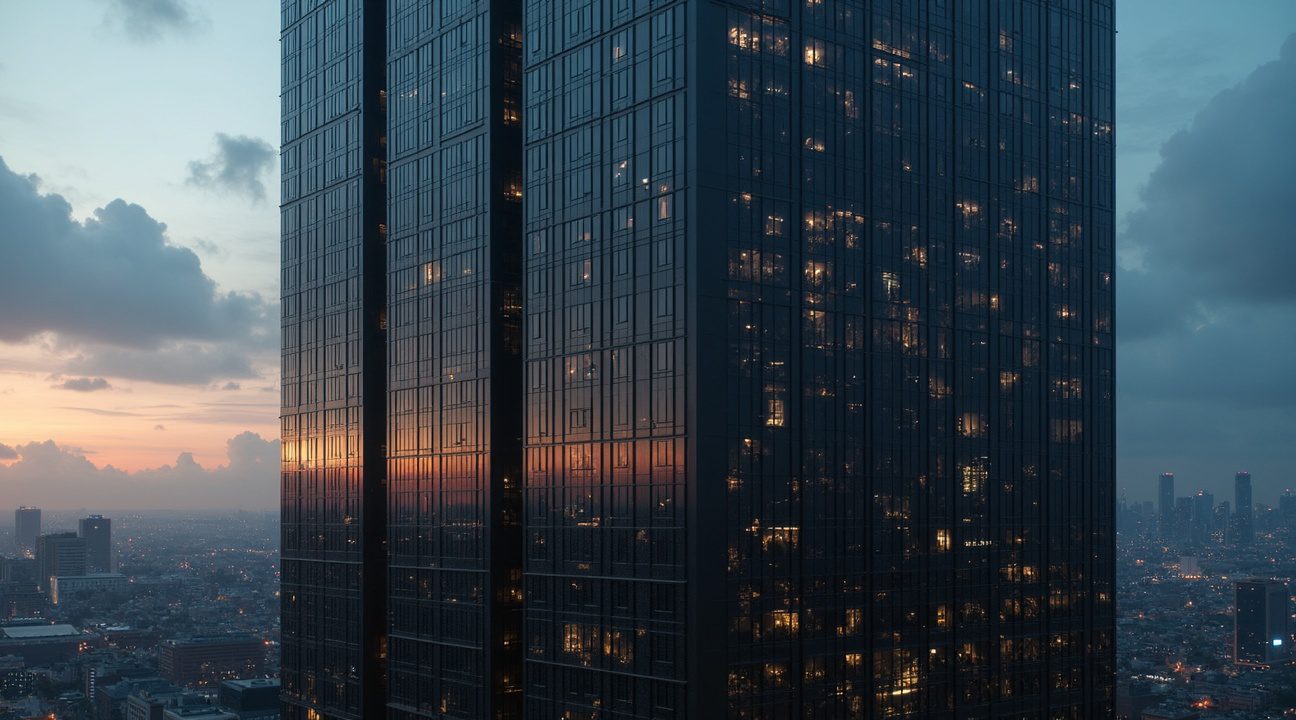
Sources:
LADbible, “20,000 people live in Black Mirror style building in China and never need to go outside”
UNILAD, “Realtor gives an inside look at ‘dystopian’ building where 20,000 residents never need to go outside”
LADbible, “Images show inside of ‘Black Mirror style’ building that houses 20,000 people”

